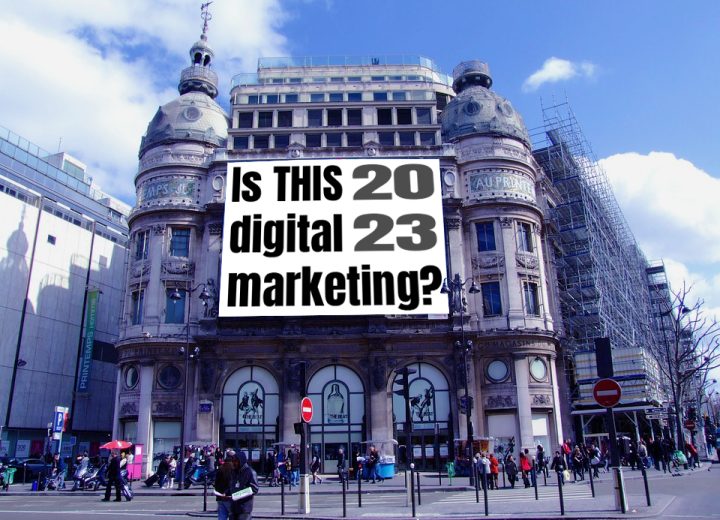Digital Marketing Trends in 2023
Digital marketing? At this point, it’s just marketing
Welcome to 2023.
Over the last ten years, it was easy to separate digital marketing and marketing. In 2013 it was all so new and exciting, everything else seemed old and out of date.
A bright new online, digital-focused future to replace the old world of TV, print and anything else that wasn’t on a phone or computer.
At the time, this did make sense. There was a lack of innovation in many of these forms of media, they were comfortable, and the online giants of Facebook and Google turned the tables upside down. But it’s not 2013 any more, and even TV these days is delivered digitally with many of the same media controls that online platforms used to boast about to set them apart from ‘The Old World’. Whether it’s geographic targeting or cost of entry, it’s one and the same – they’re just different sized screens.
The argument about difference was really a marketing exercise in and of itself by certain online providers and their obsessives to fight for dominance, and for a time they won over many. For a few years there seemed to be a battle between ‘traditional’ and ‘digital’ marketing in both the industry press and in practice. It appeared as though digital had won, but soon the ranting and raving stopped.
In 2023 it’s fair to say that digital marketing is redundant; it’s just marketing. It’s almost like saying electric marketing or analogue marketing. It’s a pointless prefix; it’s just marketing, and most marketing is digital, rendering the whole distinction somewhat tired and pointless in 2023.
While it may be true that people who work in marketing have titles such as Digital Marketing Manager, we’re definitely past the point of saying it’s an entirely separate field distinct from ‘traditional’ marketing.
As an agency we choose the right media for the right audience. That means we mix news releases with printed material and supplement it with video creative that’s pushed out on social media channels and YouTube. And for other clients, we do it differently. There is no out-of-the-box method – every client is different. That’s just good marketing.
A simple example: you’ve got a big trade show, but this year you want to go all in and get as much attention as possible. That means getting a speaking slot, recording videos to showcase your business at the event stand and promoting your attendance through targeted LinkedIn advertising.
The point is to be creative in how you communicate and reach your customers. It’s not about what everyone else is doing, or the current hype cycle – it’s about what works for your business. And what will work for your business is choosing the media your market consumes.
Marketing was always going to eat digital marketing, not the other way around.
Goodbye attribution obsession, hello reality
The holy grail for marketers is to reach the perfect customer, perfectly understand how they got to the point of purchase, and then to optimise the media spend to get the highest possible ROI for the lowest cost.
But the holy grail doesn’t exist, and it’s a cursed chalice anyway – I’m sure you’ve seen Indiana Jones.
Google and Meta (Facebook) have finally bitten the bullet and stopped overselling their promised marketing utopia of perfect attribution. They now recognise and accept the reality of the customer.
And that means variables – but what is a variable?
A variable is something that can affect an outcome, the outcome being a sale. All purchases are affected by a host of variables and that includes some things that are in the control of marketers and many more that are not. Econometrics is the science of understanding that by using models.
The problem with attribution is that it’s marketing with blinkers on; it looks only at the things a marketer can control and wrongly assumes this is the best way to work out credit along that customer journey. It fails completely to factor in variables such as seasonality, economic conditions and media that isn’t attributable.
This can cause frustration, as those not in the know will wrongly overspend on direct media such as PPC because the measurement is attribution based – creating the illusion of control.
A simple counterpoint to attribution is that a successful series of broad mass market news releases will reduce the cost of customer acquisition over time. This is a direct result of ESoV (Effective share of voice) which in English means, you’re shouting louder than the competition so you will get more people noticing your business.
But if you only use attribution, you’ll assume wrongly that your lower customer cost is to do with your twisting and turning of various cogs within your PPC campaign rather by the press campaign which has improved perceptions and awareness of the business.
Unfortunately, humans have a nasty habit of seeing patterns and causes where there are none, and attribution feeds into this human urge for pattern recognition which is driven by an emotional need to feel in control and then justified with the ‘logic’ of attribution.
Econometrics allows businesses to understand how everything comes together – it shows businesses that they don’t control everything, and much of their job is navigation of the unknown and the unexpected and not to simply try to command and control their customer, which will never work.
The current barrier to econometrics is the time and cost to implement, but where there is a problem there is a solution and we’re hopeful that in time there will be accessible tools for smaller businesses to create their own econometric models to ensure their media spend and marketing efforts are better balanced.
Facebook for example is working on its own econometrics modelling software for advertisers under the name of Project Robyn.
Go broad, and go long
Relating to the end of the attribution hype is the fact that businesses are now starting to realise that advertising over the past 100 years was probably done the way it was for a reason.
While it’s attractive to be new and shiny, it’s not so clever when it’s just an old hat wrapped in tin foil.
Broad reach advertising works because it reaches a decent size of the market. And the longer that advert is running, the more familiar it becomes to the market. The more familiar it becomes to the market, the more likely it is to be considered for purchase. And this applies just as much to B2B as it does for B2C.
The evidence is there for those who care to look, and it’s been the same way since about 1960.
The lesson for businesses here is to spend what you can, go as broadly as you can and for as long as you can. If you need money now, then of course you go short to drive immediate sales. But that will eventually dry up anyway, so a portion of the budget must always go on reaching the market broadly and with a key message that’s communicated creatively.
But… go tight, and go short
Any half decent marketer will know what the marketing funnel is. And any half decent marketer will know that the different stages of their average customer can be mapped to the funnel, to give an understanding of what media and approach needs to be used at what stage of the funnel.
And that means using a mix of both longer term, creative and attention grabbing advertising for those who are not ready to buy but are a potential future customer and then using shorter term actions to get those who are ready to buy through the door using tightly targeted, more sales driven messaging and approaches.
SC










